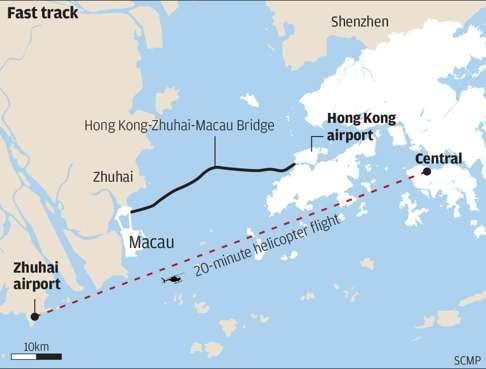
Zhuhai offers to take load off congested Hong Kong airport
Underutilised Zhuhai airport is trying for a permit that would allow it to share some of the international business jets and helicopters struggling to find space at overcrowded Hong Kong airport.
Zhuhai airport, in which the Hong Kong Airport Authority owns a 55 per cent stake, aims to get the clearance by next year, said its general manager Albert Yau. “That would mean business jets coming from anywhere could land and offload passengers in Zhuhai directly, instead of having to wait for hours and get undesirable slots in Hong Kong,” he told the South China Morning Post.

Once the customs arrangements are in place, a cross-border helicopter route between Zhuhai and Hong Kong could be created to shuttle the passengers to Central in 20 minutes, beating the Hong Kong-Zhuhai-Macau bridge that is expected to come on stream in 2018, he said.
Hong Kong’s increasingly crowded airport, which handles more than 1,100 commercial flights a day, is struggling to handle private jets already based here, let alone those from outside. Fewer than 70 parking spots for business jets are available at the airport while landing slots are even more scarce. A new online system to manage both parking and landing has allegedly only added to the problem.
“Allowing Zhuhai the permit would be the best solution to relieve HKG airport’s ramp until the third runway is built,” said Charlie Mularski, chairman of the Asian Business Aviation Association. “Greater China airspace has to be managed as one, the sooner the better, and we can all benefit from the more flexible and efficient use of the civilian airspace,” he said.
Zhuhai, the Pearl River Delta’s least used airport, plays host to China’s biggest biennale air show but gets no international flights. It has a 66,000 square metre air show centre next to the airport that sits mostly empty and can house up to 50 large business jets.
The airport itself is operating at less than half its designed capacity, handling 4.7 million passengers last year, compared with 60 million each in Hong Kong and Guangzhou.
Yau said the proposal, developed in consultation with the Hong Kong airport, would be a win-win for both and is pending approval of various authorities in Beijing. A trial run has already been cleared – in January it got a six-month temporary permit to handle international business aircraft without passengers, which, Yau expects, could amount to six to eight a month in the next two months.
Though the cost of landing and parking in Zhuhai will be cheaper than in Hong Kong, there is a “compensation and administration fee” of US$3,800 every time a non-mainland-Chinese aircraft crosses its airspace. Mularski said his association is lobbying to have this fee scrapped as it creates a high barrier to entry.
“As we are in the same industry, it is good if more planes come to China. We also look forward to opportunities of cooperation,” said Sheree Cheung, director of the Administration and Business Development at Hong Kong Business Aviation Centre, which currently enjoys a monopoly of the ground services for business jets in Hong Kong.

